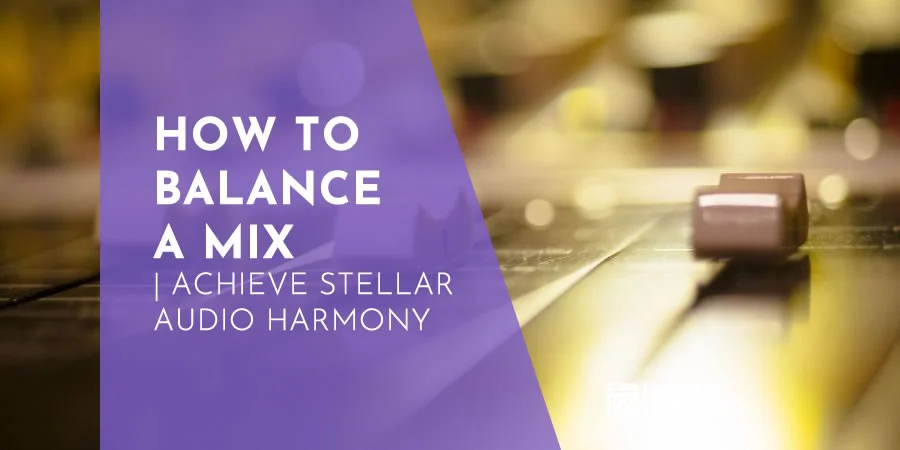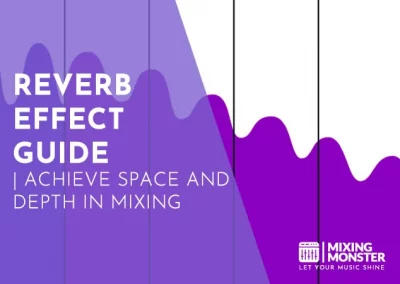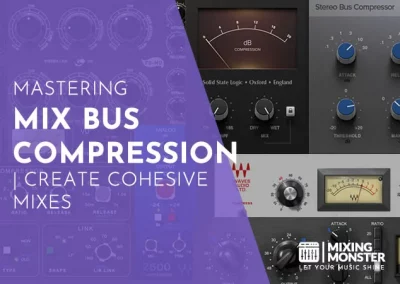Home > Blog > Mixing > Mixing Techniques
Disclosure: Some of the links below are affiliate links, meaning that at no additional cost to you, we will receive a commission if you click through and make a purchase. Read our full affiliate disclosure here.
Achieving a balanced mix is crucial for creating a finished track that sounds professional and engaging across all playback systems. Whether you are a budding producer or an experienced audio engineer, mastering how to balance a mix can take your work from good to great. In essence, audio mixing can be described in one word: Balance.
A balanced mix ensures that every element of your track has its own space in the frequency spectrum, with each instrument and vocal part audible without overpowering the others. It involves a series of steps to achieve a harmonious blend, including volume leveling, equalization, and dynamic processing. By setting the proper levels, panning instruments for a wide stereo image, and applying EQ and compression with precision, you can create a mix that sounds polished and cohesive.
As you delve further into the article, you’ll be equipped with the methodologies and tools professionals use to craft clear and impactful mixes. You will learn the ‘how’ and the ‘why’ behind each step, from foundational audio mixing concepts to advanced tonal balancing techniques. We’ll guide you through practical approaches for referencing tracks, using audio metering tools, and conducting listening tests on different systems to ensure your mix translates well everywhere.
KEY TAKEAWAYS:
- A balanced mix ensures clarity and a professional sound.
- Key elements include careful leveling, EQ, and dynamic processing.
- The article provides practical techniques and tools for mixing.
Table Of Contents
1. Understanding The Foundations Of Audio Mixing
2. Creating A Static Audio Mix For Clarity
3. The Power Of Equalization
4. Dynamics Control With Compression
5. Advanced Techniques For Tonal Balancing
6. The Art Of Referencing Audio Tracks
7. Audio Metering And Monitoring Tools
8. The Final Check: Listening Tests On Different Systems
9. Achieve Stellar Audio Harmony In Audio Mixing
10. FAQ

1. Understanding The Foundations Of Audio Mixing
Before diving into specific techniques, it’s crucial to comprehend the underlying principles of audio mixing. These foundations are pivotal for creating a polished and impactful final product.
The Role Of Gain Staging In A Balanced Mix
Gain staging is the first step you must master when approaching a mix. This process involves adjusting the levels of each track to ensure that they are set appropriately before applying any effects or processing.
Proper gain staging prevents clipping, allows for adequate headroom, and contributes to achieving a balanced mix where no single element overpowers the rest.
Leveling And Loudness Norms In Modern Audio Engineering
Leveling across different audio tracks is about achieving an even balance throughout your mix. It’s crucial to adhere to loudness norms to ensure your mix translates well across various playback systems.
Additionally, modern audio engineering practices involve using loudness meters and setting target levels—for instance, to the industry-standard LUFS (Loudness Units Full Scale)—to maintain consistency in your mixing process.
2. Creating A Static Audio Mix For Clarity
In a static mix, you aim to ensure clarity by balancing the levels and utilizing panning effectively. This stage is fundamental before adding any dynamic processing.
Steps To Achieve A Rough Balance
- Set Initial Levels:
Begin by adjusting the volume of each track to avoid any one element overpowering the others. Aim for a level where the main elements can be heard clearly but retain headroom for further adjustments. - Reference Tracks:
Use well-balanced mixes as guides. Listen to how the instruments sit in a mix and aim to mirror that balance in your work. - Critical Listening:
Pay close attention to frequency masking. Ensure that no two instruments compete in the same frequency range, which can cause muddiness. - Subtractive EQ:
Remove frequencies that don’t contribute to the sound of an instrument to make room for others to shine through, enhancing overall clarity.
The Importance Of Panning In A Mix
- Stereo Field Considerations:
Panning helps place your mix’s elements across the stereo field. Think of panning as positioning each sound in a three-dimensional space. - Center Positions:
Start by placing key elements, like the lead vocal, kick, snare, and bass, centrally as they form the foundation of most mixes. Effective stereo positioning can provide clarity and space. - Pan Positions:
Move supporting elements from the center to the left or right to create width. Remember that extreme panning can lead to an unbalanced mix on different playback systems. Aim for a natural sound field with balanced left and right channels.
3. The Power Of Equalization
In crafting a balanced mix, equalization (EQ) is your precision tool, enabling you to manipulate frequencies to achieve tonal balance and clarity. It’s not just about adjusting levels; it’s about shaping your sound landscape.
Cutting And Boosting Frequencies For Balance
Cutting frequencies is a subtractive technique to remove unwanted resonances or to reduce frequency overlap, thus preventing muddiness, particularly in the bass region. F
or example, if the bass guitar competes with the kick drum, you might cut the overlapping frequencies from the bass guitar to allow the kick drum to punch through.
- Cut To fix:
Identify problematic frequencies and reduce them to eliminate issues. - Be Surgical:
Use narrow EQ bands to avoid affecting desired tones.
On the other hand, boosting frequencies adds presence or brightness to tracks that sound dull or are being masked by different sounds. Boosting the treble can enhance the clarity of vocals or add sparkle to cymbals. However, be reasonable with boosting, as it can introduce noise or cause ear fatigue.
- Boost For Enhancement:
Carefully amplify frequencies to improve the character of instruments. - Avoid Overdoing It: Excessive boosting can make your mix sound artificial.
EQ Techniques For Clarity And Separation
Achieving clarity and separation in your mix involves mindful EQ adjustments. Here’s how:
- Carve Space:
Assign a dominant frequency range to each instrument to avoid clashes. - Use High-Pass Filters to remove low-end rumble from tracks that don’t need bass frequencies.
- Apply notch filters to remove specific, narrow frequency bands where overlap occurs.
Pan instruments are placed across the stereo field for separation, and EQ adjustments that complement their spatial placement are made. For instance, slightly boosting the higher frequencies of an instrument panned to the side can increase its perceptibility.
- Utilize Stereo:
Pan instruments and sculpt their EQ to enhance their placement. - Control Dynamics:
Use compression in conjunction with EQ to maintain clarity.
4. Dynamics Control With Compression
Utilizing compression is crucial to achieve a well-balanced mix. It allows you to manage the dynamics effectively, ensuring all elements sit comfortably in the mix.
Using Compression To Maintain Consistent Levels
When you apply a compressor to an audio signal, you’re essentially narrowing the dynamic range—the difference between the loudest and softest parts. By setting the correct threshold level, the compressor activates only when the signal exceeds this volume.
This helps to maintain consistent levels across your mix. You must carefully adjust the ratio to determine how much the audio that exceeds the threshold will be compressed. A lower ratio can subtly even out a performance, while a higher ratio will clamp down more aggressively on louder sections.
Understanding Dynamic Range In A Balanced Mix
The dynamic range in a mix is pivotal for it to sound lively and vibrant. A balanced mix should retain the natural fluctuations in volume that convey emotion and energy. To preserve this, use your compressor’s threshold and ratio settings judiciously.
Set your threshold to catch only the genuinely disruptive peaks, and choose a ratio that reduces these peaks to a level consistent with the rest of the track without squashing the life out of the performance. Doing so ensures that your mix breathes naturally while sounding polished and professional.

5. Advanced Techniques For Tonal Balancing
To enhance your mix, mastering the use of advanced techniques is crucial. This section focuses on employing sophisticated dynamics processing to refine the tonal balance and add richness to your tracks.
Multiband Compression And Side-Chain Techniques
Multiband compression is pivotal in sculpting your mix’s tonal balance across different frequency ranges. You can apply compression selectively to bass, mids, and treble to control the dynamic range, ensuring each band sits perfectly in the mix without overpowering others.
Apply Multiband Compression:
- Low Frequencies:
Tighten the bass and maintain punchiness without muddiness. - Mid Frequencies:
Add clarity to vocals and lead instruments. - High Frequencies:
Tame harshness in cymbals and high-end elements.
Side-chain techniques allow you to duck specific frequencies or entire tracks out of the way when some aspects, like kick or bass, hit. This results in a cleaner, more dynamic mix that breathes with the rhythm.
- Implement Side-Chaining:
Key a side-chain compressor to a kick drum to create space for your bass. - Side-chain to vocals to ensure they remain prominent against competing instruments.
Exciters And Enhancers To Add Depth And Presence
Exciters and enhancers introduce additional harmonics to your mix, infusing it with depth and presence without significantly increasing peak levels. This subtlety enriches perceived dynamics and can make individual tracks more distinct when used correctly.
- Harness The Power Of Exciters:
Add to vocals for increased warmth and brightness. - Use synths to give them a more analog feel.
Enhancers work on specific frequency ranges to improve the effects of depth and presence. The strategic application can introduce new dimensions to your soundscape.
Benefits Of Strategic Enhancement:
- Subtlety Is Key:
Subtle enhancement can make your track feel more “alive.” - Selective Application:
Apply only to lackluster tracks, avoiding over-processing.
Utilize these advanced techniques judiciously to transform your mix from good to great, providing a more engaging and immersive audio experience. Remember, less is often more when it comes to dynamics processing—your goal is balance and depth, not overbearing effects.
6. The Art Of Referencing Audio Tracks
In the mixing process, integrating reference tracks can critically shape your mix’s sonic character and balance. By carefully selecting a reference track, you position your mix to meet industry standards and align with professional quality.
How To Use Reference Tracks For Consistency
When balancing your mix, referencing tracks allows for a consistent sound compared to your chosen tracks. The first step is to match the level of your reference track with your mix.
This ensures the difference in volume does not mislead you and prevents overcompensating through EQ or compression. Applying this approach after you’ve managed your essential gain staging is advisable. Matching levels is crucial to a fair comparison.
Another key aspect is analyzing the frequency balance. Your reference should guide your EQ decisions by serving as a benchmark for tonal balance. Listen for how the bass, mids, and treble are distributed in your reference and adjust your mix to maintain a competitive musical impact.
A/B Testing Against Industry Standards
A/B testing your mix against a proven reference track offers an objective perspective on where your track stands relative to industry standards. Listen to both tracks alternately, focusing on textural elements, stereo width, and dynamic range.
This comparison helps identify discrepancies and needed adjustments to bring your mix up to par. For A/B testing to be effective, the reference track must be carefully chosen; it should reflect the genre and style you’re targeting for your mix.
Industry-standard referencing ensures that your track does not sound good in isolation but holds its ground when played alongside current hits.
To enhance the effectiveness of referencing, adjust your mix in mono and stereo. This widens your mix’s compatibility across various playback systems. Remember, the goal is balancing, not replication. Your mix should retain its unique identity while benefiting from the quality standards set by your references.
7. Audio Metering And Monitoring Tools
Audio metering and monitoring are essential in achieving a well-balanced mix. They allow you to visualize and control the levels, which is critical for ensuring your mix translates well across different listening environments.
Visualizing Audio With Modern Metering Tools
Today’s digital audio workstations (DAWs) often come equipped with a robust set of metering tools that allow you to visualize your mix in various ways.
For instance, iZotope’s Insight offers a comprehensive suite of meters that can analyze levels across different dimensions, including loudness, peaks, and stereo images. When mixing, visual feedback helps make critical decisions about volume levels.
If certain parts of your mix consistently hit the red on the meter, you know you need to adjust the gain or apply compression to avoid clipping.
The Importance Of Accurate Monitoring In Mixing
Accurate monitoring ensures what you hear is a true representation of your mix. Your monitor speakers or headphones should provide a flat frequency response, allowing you to judge the balance of frequencies accurately.
This is where volume levels play a vital role; monitoring at consistent levels can prevent you from making erroneous boosts or cuts in your mix. Remember, the goal is to achieve a good mix of various audio systems, not just your studio monitors.
Reliable monitoring tools are your ears’ best friend in the mixing process, guaranteeing you make adjustments based on accurate sound rather than guesswork.
8. The Final Check: Listening Tests On Different Systems
After meticulous mixing, the final check is critical to ensure your track sounds great on all playback devices. This involves structured listening tests across various systems.
Testing Your Mix On Various Audio Systems
Your mix should maintain its quality across a variety of audio systems. Here’s how to conduct effective listening tests:
- Studio Monitors:
Listen to your mix on flat-response studio monitors to gauge its neutrality. - Studio Headphones:
Use high-quality headphones to check for the stereo field’s integrity and the balance of individual elements. - Consumer Speakers:
Play the mix through typical consumer-grade speakers to anticipate household listening scenarios. - Car Sound Systems:
Test the mix in a car to evaluate performance on standard automotive audio systems. - Portable Devices:
Pay attention to playback on laptops, smartphones, and tablets, as these are prevalent among listeners.
Adjusting For Different Listening Environments
- Room Acoustics:
Adjust for variations in room acoustics where bass frequencies might be overrepresented or swallowed. - Speaker Positioning:
Assess the spread of the stereo field and check for any phasing issues. - Volume Levels:
Listen at different volumes to ensure your mix’s dynamics perform consistently. - Reference Tracks:
Compare your mix against well-balanced reference tracks to achieve a competitive output.
Remember, the goal is not to make drastic changes but to fine-tune your mix to perform reliably in various listening environments.
9. Achieve Stellar Audio Harmony In Audio Mixing
Mastering the art of audio balance is crucial for producing a mix that sounds professional and harmonious. This section will guide you through essential strategies and ongoing practices to refine your mixing skills.
Recap Of Key Points On How To Balance A Mix
- Gain Staging:
Ensure you start with proper gain staging to maintain headroom and avoid clipping. - Equalization (EQ):
Use EQ to sculpt and separate frequencies, ensuring each element sits nicely in the mix without competing for space. - Compression:
Apply compression wisely to control the dynamic range and maintain consistent volume levels across all elements. - Panning:
Utilize panning to place each sound within its stereo space, achieving a wider and more immersive sound. - Reverb And Delay:
Use these effects to create depth and spatial context, but do so sparingly to prevent a muddy mix. - Referencing:
Regularly reference your mix against well-balanced tracks to gauge your progress and make adjustments. - Automation:
Implement automation to make real-time adjustments to volume, panning, and effects for a dynamic mix.
Keep Experimenting And Learning In Audio Mixing
It’s vital to embrace experimentation and continued education in audio mixing. Dive into mixing resources and tutorials, attend workshops, and critically listen to music from various genres to understand different mixing techniques.
Your skill will improve with each mix you work on, informed by successes and mistakes.
Happy balancing!
10. FAQ
1) What is the ideal way to set levels for each instrument in a mix?
Set levels starting with the most prominent element, often the vocals or lead instrument, then adjust the others to support it. Levels should allow each instrument to be heard clearly while maintaining its role within the mix.
2) How can one achieve a well-balanced relationship between kick and snare drums?
Balance kick and snare by ensuring they are not competing for the same frequency space. Adjust levels so the kick is solid and the snare is crisp, applying EQ and compression as needed to maintain a punchy and complementary relationship.
3) What are some techniques for ensuring vocals sit properly in the mix?
Ensure vocals sit well in the mix by using EQ to carve out space, applying compression for consistent levels, and adding a touch of reverb or delay for spatial context. Automate volume where necessary to keep the vocals prominent in crucial sections.
4) What is the visual representation of a properly balanced mix on a spectrum analyzer?
A properly balanced mix on a spectrum analyzer typically shows lower frequencies centered around the kick and bass, a well-defined midrange where most instruments sit, and a smooth high end without spikes, indicating a good distribution across the spectrum.
5) Please guide me on how to use a volume-balancing cheat sheet effectively.
A volume balancing cheat sheet can provide a starting point for setting levels. Use it as a reference, but adjust according to your mix’s needs, considering the genre, arrangements, and desired sonic impact.
6) What are the standard mixing levels in dB for creating a balanced mix?
Standard mixing levels in dB vary by genre and the elements within a mix, but a good practice is to keep the overall mix peak around -6dB to -3dB, allowing adequate headroom for mastering. Individual track levels should support a balanced mix without any element overpowering the others.





















